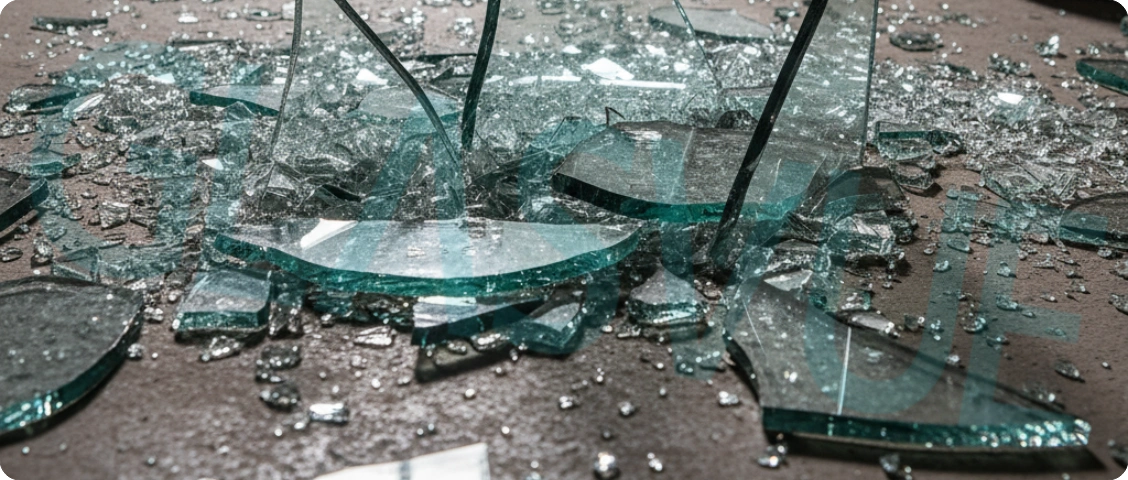Introduction
Living in a busy city or working on a bustling project, you need glass that’s tough as heck. Flimsy stuff that shatters at the slightest bump? No thanks. Tempered glass is your heavy hitter, packing way more strength than float glass. This article spills the beans on why impact resistance matters, how these two stack up, and why tempered glass is your go-to for projects that demand grit and safety. Let’s dig in.
Why Impact Resistance Counts
Impact resistance in glass is critical for several reasons:
Safety Protection
Glass that shatters easily under impact can produce sharp shards, posing a serious risk of injury. Glass with high impact resistance reduces this danger, enhancing overall safety.
Structural Stability
In public buildings, curtain walls, railings, doors, or windows subjected to external forces or frequent use, glass with strong impact resistance maintains long-term stability, resisting cracks from impacts or pressure.
Resilience to Unexpected Events
Whether facing natural factors (wind pressure, temperature fluctuations) or human-related incidents (accidental impacts, vandalism), glass needs sufficient toughness and strength to avoid sudden failure.
Reduced Maintenance and Replacement Costs
Glass with superior impact resistance is more durable, offering a longer lifespan and reducing the frequency of damage, which lowers maintenance and replacement expenses.
Float Glass Basics

Float glass is the everyday stuff you spot all over, but it’s not built for the rough stuff.
What’s Float Glass?
Imagine molten glass poured over a pool of melted tin, cooling into super-smooth sheets. It’s cheap, easy to whip up, and shows up in windows, mirrors, or even your IKEA coffee table. But when it comes to taking hits, it’s kind of a lightweight.
Why Float Glass Flops
Float glass cracks like a dropped plate if something smacks it. It breaks into wickedly sharp shards that can cut you bad. Edge bumps or a quick shift from hot to cold? It’s done for. I had a float glass window in my old apartment crack just because the sun heated it up and a cold breeze hit. For high-risk spots like shops or railings, it’s just not tough enough.
Cooling Process and Internal Stress Distribution
Float glass undergoes slow, natural cooling during the annealing process, resulting in minimal residual internal stress. While this ensures excellent optical clarity and flatness, it lacks additional “prestressing.” When impacted, float glass cannot disperse or resist external forces through internal stress, making it prone to breaking.
Brittle Material Characteristics
Glass is inherently a brittle material with little to no plastic deformation under tensile stress. Float glass, lacking internal stress reinforcement, allows cracks to propagate rapidly upon impact, leading to immediate fracture.
Tempered Glass Overview

Tempered glass is the big dog, built to shrug off punishment and keep you safe.
How It’s Made
- Raw Material Preparation: Ordinary float glass is cut, edged, or drilled as needed.
- Heating: The glass is heated to approximately 620–650°C, close to its softening point.
- Rapid Cooling: High-pressure cold air is blown uniformly to cool the surface rapidly while the interior remains hotter.
- Stress Layer Formation: The surface contracts under compression, while the interior experiences tension, creating a “compressive stress layer” that enhances overall strength.
What Makes It Awesome
- Increased Strength: Tempered glass has 3–5 times higher impact and bending strength than float glass.
- Thermal Stability: It can withstand temperature differences of over 200°C, compared to about 60°C for float glass.
- Fragment Safety: When broken, it shatters into blunt, granular pieces, reducing the risk of secondary injuries.
Potential Snags
Non-Cuttable/Post-Processing Limitations
Once tempered, the glass cannot be cut or drilled without shattering. All deep processing must be completed before tempering.
Self-Explosion Risk
Standard tempered glass may contain nickel sulfide (NiS) impurities, which can cause “spontaneous breakage” under temperature changes or prolonged stress accumulation.
Stress Marks (Optical Interference)
Uneven cooling airflow during tempering can create stress differences across the glass surface, resulting in visible “rainbow-like” optical interference patterns or spots, affecting aesthetics.
Glasvue Solutions:
- Heat Soak Test (HST): Tempered glass is placed in a 290°C environment for several hours to trigger potential self-explosions, reducing the risk of spontaneous breakage during use.
- Ultra-Clear Glass Tempering: Ultra-clear glass, with minimal NiS impurities, reduces the self-explosion rate to approximately 0.1%, significantly enhancing safety.
- Glasvue uses the Finland GLASTON Dual-Chamber Tempering Furnace, featuring:
Forced Convection Heating: More uniform than traditional radiant heating, reducing temperature variations across the glass.
Dual-Chamber Design: Segmented heating and balanced temperature control ensure consistent surface temperatures, minimizing stress disparities.
Intelligent Air Pressure Control: Dynamic adjustment of cooling air pressure based on glass thickness and size reduces localized cooling differences. These technologies significantly reduce stress marks, improving transparency and visual quality.
Comparison: Tempered Glass vs. Float Glass
Let’s throw these two in the ring to see why tempered glass comes out swinging.
Mechanical Properties
| Property | Float Glass | Tempered Glass |
| Impact Strength | Basic strength, prone to breaking | 3–5 times higher, impact-resistant |
| Bending Strength | Low | 4–5 times higher |
| Thermal Shock Resistance | Low (cracks at ~60°C temperature difference) | High (withstands ~200°C temperature difference) |
Safety
| Property | Float Glass | Tempered Glass |
| Fragment Shape After Breaking | Large, sharp shards, highly dangerous | Blunt, small granules, low risk of secondary injury |
| Self-Explosion Risk | No NiS-related self-explosion | Present, but mitigated with HST or ultra-clear glass |
| Stress Distribution | No internal stress | Uniform internal stress distribution, enhancing strength |
Processing and Adaptability
| Property | Float Glass | Tempered Glass |
| Cutting/Drilling | Can be processed post-production | Cannot be processed after tempering; all processing must occur beforehand |
| Heat Bending | Slightly bendable | Cannot be bent after tempering |
Optical Performance and Appearance
| Property | Float Glass | Tempered Glass |
| Light Transmittance | High | High (stress marks may slightly affect clarity) |
| Rainbow Patterns/Stress Marks | None | Present, but reduced with Glaston dual-chamber furnace |
| Appearance | Smooth and transparent | Smooth and transparent, slight optical distortion possible in thicker glass |
Applications of Tempered Glass
You’ll find tempered glass in places where strength and safety aren’t just nice—they’re a must.
Busy Areas

Storefronts, schools, or gyms need glass that can handle the chaos. Tempered glass stands up to shopping cart bumps, kids horsing around, or stray volleyballs. It keeps everyone safe, no matter how wild things get.
Structural Jobs

Railings, staircases, or building facades need glass that’s tough as nails. Tempered glass supports heavy loads and weathers storms without cracking. It’s built to stick around for the long haul, no matter the job.
GLASVUE’s Tempered Glass Solutions

Need tempered glass that fits your vibe? GLASVUE has your back with custom options and serious know-how.
Pick Your Flavor
You’ve got tons of choices: clear, tinted, ultra-clear, Low-E, heat-reflective, or ceramic-frit glass. Want to save on energy bills or make a bold statement? There’s a type for that. You’ll get exactly what your project needs, no compromises.
Custom Cuts and More
Got a funky shape or specific size in mind? You’re golden with custom thicknesses, drilling, curved designs, or weird shapes. From a quirky railing to a massive facade, your tempered glass will fit like it was born for the job.
Pro Backup
With 30 years in the game and projects all over the map, GLASVUE’s crew knows their stuff. They’ll guide you from sketch to setup, making sure your glass performs like a superstar. No stress, just results.
Conclusion
Tempered glass runs circles around float glass when it comes to impact resistance. It’s 3–5 times tougher, way safer when it breaks, and perfect for high-stakes spots where float glass would flop. GLASVUE’s custom solutions deliver strength you can count on, backed by decades of expertise. Ready to beef up your project? Reach out to GLASVUE for a free sample or tailored design to get things rolling.
FAQs
Q: How much tougher is tempered glass than float glass?
A: Tempered glass is 3–5 times stronger for impacts and 4–5 times better for bending. It takes on rough stuff without blinking.
Q: Is tempered glass safe for crowded areas?
A: You bet. Tempered glass breaks into small, dull bits, not sharp shards. It’s a solid pick for busy spots like shops or schools.
Q: Can tempered glass be tailored for unique projects?
A: Totally. You can pick sizes, shapes, thicknesses, or coatings like Low-E. GLASVUE crafts it to match your exact vision.



